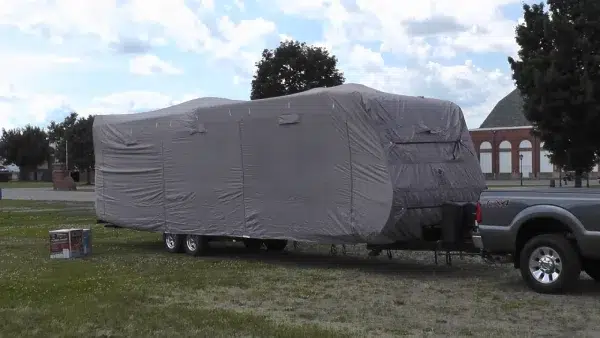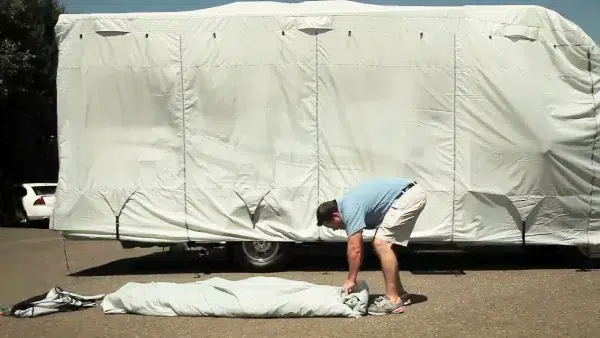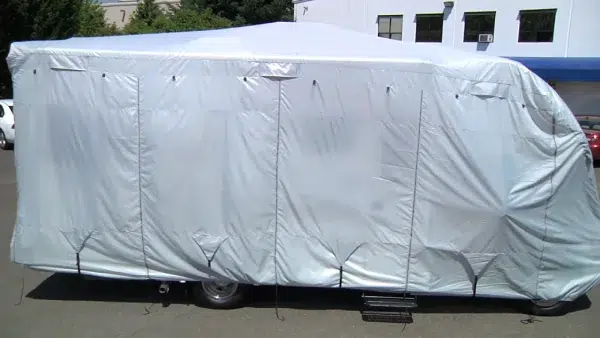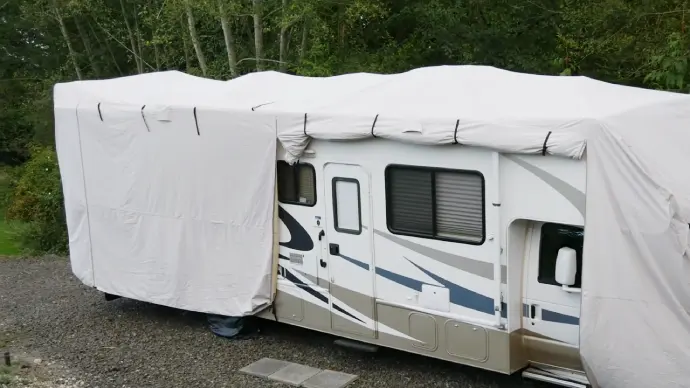Last Updated on May 2, 2023
Protecting your RV from the elements is crucial to ensuring its longevity and appearance. Investing in a sturdy RV cover can protect your vehicle from harsh weather conditions, but knowing how to clean and maintain it is essential.
A dirty cover can quickly become ineffective and even cause damage to your RV. You can easily clean your dirty RV cover by diluting an RV cover cleaner, applying it to the cover, scrubbing and rinsing it.
Today we’ll walk you through the steps to effectively clean your RV cover so that you can keep it looking great for years to come.
How to Clean an RV Cover: DIY Steps to Follow

Cleaning your RV cover is essential to maintaining your RV’s overall appearance and longevity. A clean RV cover looks great and helps protect your vehicle from harmful elements such as UV rays, dirt, and debris.
Step 1: Preparing the RV Cover
Before you begin cleaning your RV cover, properly prepare the cover for the cleaning process. This will ensure you can clean the cover effectively without causing any damage.
The first step in preparing your RV cover is to remove any loose debris from the surface of the cover. This can be done using a soft-bristled brush or broom, gently sweeping away any leaves, dirt, or other debris that may have accumulated on the surface of the cover.
Once you’ve removed any debris from the cover, it’s essential to inspect the cover for any damages before proceeding with cleaning. Start by laying out the cover on a flat surface and examining it carefully.
Look for any tears, holes, or other types of damage. Pay special attention to areas prone to wear and tear, such as corners or edges.
If you notice any damage, note the location and extent of the problem. Depending on the severity of the issue, you may need to repair or replace your RV cover before cleaning it.
Step 2: Determine the Type of Cleaner to Use
Choosing the right cleaner is crucial to ensure it stays in good condition for years. The type of cleaner you use will depend on the material of your RV cover and any specific instructions from the manufacturer.
Start by checking the manufacturer’s instructions for recommended cleaners or cleaning methods. You can use a basic cleaning solution such as mild soap and water if no specific instructions are given. But if your RV cover has tough stains or heavy dirt buildup, you may need a specialty RV cover cleaner.
Specialty RV cover cleaners are formulated to clean effectively without damaging the material of your RV cover. They often contain ingredients that help remove stubborn stains and protect against UV rays and other environmental factors that can cause damage over time.
Step 3: Dilute Cleaner, If Necessary
When cleaning your RV cover, it is essential to use the right cleaner to avoid damaging the material. Some RV covers require a specialty cleaner, while others can be cleaned with basic supplies. If you need a specialty cleaner, check the manufacturer’s instructions for the recommended product.
Once you have determined which cleaner to use, you may need to dilute it depending on the concentration of the product. Follow the instructions carefully and mix in a bucket before applying it to your RV cover.
Step 4: Apply Cleaner to RV Cover
Once you have all the materials ready, it’s time to start cleaning. To apply the cleaner, you can use a soft-bristle brush or sponge. It’s important to avoid using abrasive brushes or sponges that may damage the cover. A gentle touch will help remove dirt and stains without harming the cover material.
When applying the cleaner, pay extra attention to areas with stains or heavy dirt buildup. These areas may require a little extra scrubbing to get them clean. Be sure to follow any instructions the manufacturer provides for recommended cleaning techniques.
Step 5: Scrub Gently with Soft-Bristle Brush or Sponge
You can use a soft brush or sponge to scrub away dirt or grime. Avoid using hard brushes or sponges, which can damage the cover. Also, avoid using too much pressure or scrubbing too vigorously, as this can cause damage.
It’s also important to avoid using any harsh chemicals or cleaners that could potentially damage the material. Stick with specialty RV cover cleaners or mild soap and water solutions.
Step 6: Rinse Thoroughly with a Hose or Bucket of Water
After scrubbing, rinse off all excess cleaner and dirt from your RV cover thoroughly with water. Make sure no residue is left behind before moving on to drying and storing your RV cover properly. Remove all traces of cleaner, as leaving any residue on the cover can cause damage over time.
Once you have finished rinsing, allow the RV cover to air dry completely before storing it away. Do not use a dryer or heat source, which can damage the cover’s material. Also, avoid leaving it in direct sunlight while wet.
Materials and Tools Needed for Cleaning an RV Cover

You will need a few materials and tools to clean an RV cover correctly.
#1 Basic Cleaning Supplies
You’ll need some basic cleaning supplies to complete the job when cleaning your RV cover. These supplies include a soft-bristle brush or sponge, a hose or bucket of water, and a cleaning solution.
#2 Specialty RV Cover Cleaners
While basic cleaning supplies like soap and water can be effective, specialty RV cover cleaners are designed specifically for this purpose. They can provide a deeper clean without damaging the material.
When choosing a specialty RV cover cleaner, it’s important to check the manufacturer’s instructions for recommended products. Some covers may require a specific type of cleaner or restrict what products can be used.
#3 Soft-Bristle Brush or Sponge
A soft-bristle brush or sponge will allow you to gently scrub away dirt and stains without causing any harm to the cover. When choosing a brush, ensure it has no stiff or abrasive bristles. A sponge can also be used as an alternative to a brush, especially for areas that require more delicate cleaning.
#4 Hose or Bucket of Water
It’s important to have a hose or bucket of water when you clean your RV cover. After applying the cleaning solution, this will rinse off excess cleaner and dirt from the cover.
Drying and Storing Your RV Cover Properly After Cleaning

After cleaning your RV cover, it is essential to dry and store it properly to ensure its longevity. Improper drying and storage can cause mold, mildew, and other damages that can shorten the lifespan of your RV cover.
Step 1: Air Dry Your RV Cover Completely
To air dry your RV cover, you should spread it out flat on a clean surface in a well-ventilated area. Avoid using a dryer or any other heat source, as this can cause the cover to shrink or melt. Also, don’t leave the cover in direct sunlight while wet; this can fade the color and weaken the fabric.
If possible, try to hang the cover up using clothespins or a drying rack so that air can circulate on both sides of the material. This will help speed up the drying process and ensure that all areas of the cover are completely dry.
Depending on the size of your RV cover and available space, it may take several hours or even a full day to dry completely. Be patient and allow the cover to dry thoroughly before folding and storing it.
Step 2: Fold and Store Your RV Cover Correctly
After cleaning it, storing it to ensure its longevity properly is important. Here are the steps to fold and store the RV cover correctly:
- Fold the cover neatly: Once completely dry, fold it neatly by bringing the two ends together and then folding it half lengthwise. Then, fold it in half again width-wise.
- Roll or bag the cover: After folding it, you can either roll it up tightly or place it in a storage bag designed specifically for RV covers. If you roll it up, ensure that all of the edges are aligned and that there are no wrinkles or creases in the fabric.
- Store in a cool, dry place: Finally, store your RV cover in a cool, dry place to protect it from moisture and sunlight. Avoid storing it in areas where pests or rodents may be present.
Can I wash RV covers?
You can wash RV covers with warm water and mild detergent. It is important to ensure that your detergent is not harsh and can damage the material. Harsh detergents can weaken the fabric and cause it to tear or fade over time.
Using a soft-bristled brush, gently scrub the cover in a circular motion to remove any dirt or stains. Rinse the cover thoroughly with water and allow it to air dry completely before using it again.
How do I clean RV wheel covers?
Remove any loose dirt or debris using a soft-bristled brush to clean RV wheel covers. Then, rinse the wheel covers off with warm, clean water. It is essential not to use soap when cleaning RV wheel covers as it can leave a residue that can damage the finish.
Once you have rinsed the covers, dry them with a clean cloth or let them air dry completely.
Can I machine wash RV covers?
You can machine wash RV covers, but it is important to use a gentle detergent and wash them in cold or slightly warm water, not hot water. Hot water can shrink the covers or cause the color to fade.
It is also essential to avoid using bleach or fabric softeners as they can be too harsh and damage the material. Once the covers have been washed, allow them to air dry completely before putting them back on the cushions.
Protect Your Investment: Follow Steps for Sparkling RV Cover Care
Cleaning your RV cover is essential for maintaining the durability and protecting your investment. Whether you use basic cleaning supplies or specialty RV cover cleaners, it’s necessary to follow the manufacturer’s instructions and take care when scrubbing with a soft-bristle brush or sponge.
Once you’ve finished cleaning, air dry your RV cover completely before folding and storing it correctly according to the manufacturer’s instructions. Following these simple steps, you can keep your RV cover in top condition for years and enjoy worry-free travels with your home on wheels.


